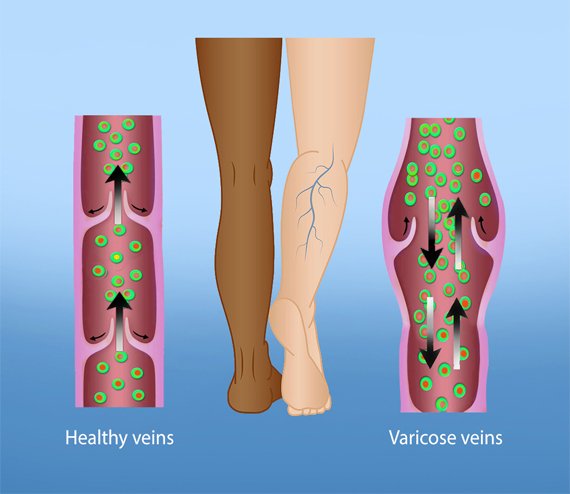VARICOSE VEINS
These are Swollen, Twisted, Over-stretched veins. You can see and often feel them lying just under your skin, usually in your legs. Varicose veins develop when blood doesn’t flow properly through the veins in your legs towards the heart. There are two main types of veins in your legs: superficial veins near the surface and deep veins within your muscles. In healthy veins, blood flows from the superficial veins to the deep veins and from there back up to your heart. The superficial veins are connected to the deep veins inside your legs by perforator veins.
Varicose veins are a sign of high pressure in your leg veins. Normally, one-way valves inside all these veins make sure that your blood goes in the right direction. If the valves stop working as they should, the blood pools in the veins in your legs. This increases the pressure inside the veins causing them to swell.

SYMPTOMS OF VARICOSE VEINS
Symptoms of varicose veins can vary. Having large varicose veins doesn’t mean that you’ll have more symptoms. Some people don’t have any symptoms at all. If you do have them, they may include:

- Lumps or bulging veins
- Aching or heaviness in your legs that usually gets worse after standing for a long time
- Cramps in your legs – usually at night
- Brown or purplish patches of skin over your ankles and lower legs
- Itching or burning over the veins that gets worse after standing
- Swollen feet and ankles – especially after standing for a long time
- A red rash normally over your ankles or shins (lower leg) – this is known as venous eczema
- Skin ulcers or wound that does not heal or heal very slowly
- It’s possible for varicose veins to bleed, but in most people they don’t. If you have any bleeding, contact your doctor immediately
DIAGNOSIS

1. Proper History

2. Good Clinical Examination

3. Colour Doppler study
With these we can come to know severity of varicose veins, distribution of varicosities, cause of varicose veins like Saphenofemoral junction / Sapheno popliteal junction / Perforator defective valve, rule out chronic DVT, peripheral arterial disease. In some cases additional studies like MRI venography and CT abdomen may be required.
TREATMENT
Treatment of Varicose veins has been revolutionized in the past decade with the implementation of laser ablation techniques. This modality of therapy has made classic surgical excision obsolete. Nowadays, Endovenous laser treatment (EVLT) is considered to be the gold standard for therapy of varicose veins./p>
Conservative Measures Include:
- Wearing Compression Stockings
- Elevating The Legs
- Exercising
- Weight Optimisation
Minimally Invasive Treatments Include:
- Ultrasound-guided foam sclerotherapy – injecting a foam solution into the vein to collapse the vein
- Endovenous Laser Therapy (EVLT) – guiding a laser fibre inside the vein. Its Thermal Ablation destroy the particular veins deep in the thigh and/or the back of the calf that feed the varicose veins using heat
- Micro- Phlebectomy – removing a superficial/surface varicose vein through 2-3 small incisions on the leg
WHAT IF I DON’T HAVE MY VARICOSE VEINS TREATED?
If you have a varicose vein that is very small and not causing pain, you may be able to self-manage it with conservative measures.
On the other hand, moderate to severe varicosities can lead to major complications, due to the poor circulation through the affected limb. In this case, prompt treatment can halt and potentially reverse your symptoms.
Left untreated, major complications may include:
- Chronic Pain, Heaviness, Or Tenderness
- Inability To Walk Or Stand For Long Periods Of Time
- Skin Conditions /Dermatitis
- Venous Ulcers – Skin Ulcers Especially Near The Ankle
- Severe Bleeding From Minor Skin Trauma/li>
- Blood Clots – These are frequently isolated to the superficial veins, but can extend into deep veins, becoming a more serious problem
- Acute Fat Necrosis – especially at the ankle of overweight patients with varicose veins. Females are more frequently affected than males
- – Development Of Carcinoma Or Sarcoma (Skin Cancer) Very Uncommon – In Long-Standing Venous Ulcers Only
If you have developed varicose veins of any size, it is advisable to explore your treatment options early. Treatment will give you the best chance of reversing any changes that may have taken place in the skin or tissues of the leg.
